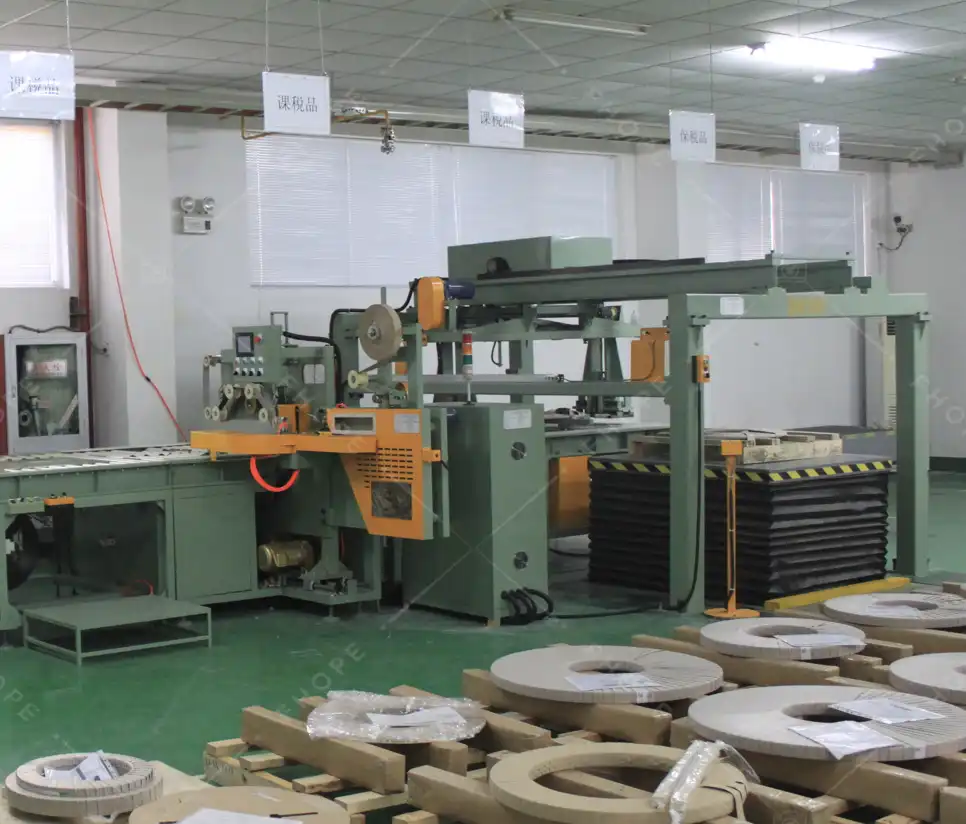Enhancing Efficiency and Safety: A Guide to Automatic Aluminum Coil Strapping Machines
Handling and packaging aluminum coils requires precision and care. Due to aluminum's relative softness compared to steel, improper handling can lead to surface damage, deformation, and costly waste. Secure strapping is essential for maintaining coil integrity during storage and transit. Automatic aluminum coil strapping machines offer a robust solution, improving efficiency, consistency, and operator safety in demanding production environments.
Further details on specific machine configurations can be explored here: http://www.fhopepack.com/Automatic-strapping-machine.html
What is an Automatic Aluminum Coil Strapping Machine?
An automatic aluminum coil strapping machine is specialized industrial equipment designed to apply straps (typically steel or PET) circumferentially around aluminum coils without manual intervention. These machines are integrated into processing or packaging lines, receiving coils via conveyors, automatically positioning them, applying the strap(s) at predetermined locations, tensioning, sealing, and cutting the strap.
This type of automatic aluminum coil strapping machine is engineered for flexibility, designed to handle aluminum coils of various sizes and shapes. Modern systems often incorporate sensors and advanced controls to ensure accurate strap placement and consistent tension, crucial for protecting sensitive aluminum surfaces.
Key Benefits of Automation in Coil Strapping
Automating the strapping process for aluminum coils provides several advantages over manual or semi-automatic methods:
- Increased Throughput: High-speed operation significantly boosts packaging efficiency, keeping pace with production line output.
- Consistent Strap Application: Automated systems apply straps with uniform tension and precise placement every time, reducing the risk of coil damage from overly tight straps or instability from loose ones.
- Enhanced Operator Safety: Automation minimizes manual handling of heavy coils and strapping tools, reducing ergonomic strains and potential injuries. Safety features like guarding and interlocks further protect personnel.
- Reduced Labor Costs: Automating the strapping process frees up personnel for other value-added tasks.
- Improved Coil Protection: Secure, consistent strapping maintains the coil's shape and protects edges during handling and shipping. Complementary protective measures, like edge protectors or stretch film wrapping (often applied in subsequent automated steps), can be used for additional safeguarding.

steel coil packing line(1) Core Features and Technical Considerations
When evaluating automatic aluminum coil strapping machines, several key features and specifications are important:
Versatile Coil Handling Capabilities
The machine must accommodate the specific range of coils processed. Key parameters include:
- Coil Outer Diameter (OD): Maximum and minimum OD.
- Coil Inner Diameter (ID): Compatibility with the coil eye.
- Coil Width: Range of widths the machine can handle.
- Coil Weight: Maximum weight capacity of the conveyor and strapping station.
Many machines can be customized to handle specific dimensions or even irregularly shaped coils.
Optimized Strapping Speed
Throughput is critical. Machines are often rated by straps per minute (e.g., capable of speeds up to 30 straps per minute, depending on coil size and strapping configuration), directly impacting overall line efficiency.
Precise Tension Control
Adjustable and consistent strap tension is vital for aluminum. Too much tension can damage the coil edges or surface; too little can lead to strap slippage and load instability. Look for systems with reliable tensioning mechanisms and controls.
Strapping Material Flexibility
Machines can be configured for different strapping materials:
- Steel Strapping: Offers high tensile strength, suitable for heavy coils.
- PET (Polyester) Strapping: Provides good strength with more elasticity than steel, reducing the risk of surface indentation on softer materials like aluminum. It also resists rust.
The choice depends on coil weight, handling requirements, and customer specifications.
Seamless Automation and Integration
These machines are designed for integration into automated lines. Features include:
- Conveyor Systems: Automated feeding and discharge of coils.
- PLC Controls: Programmable logic controllers for managing strapping sequences, integrating with upstream/downstream equipment, and diagnostics.
- Sensors: Detect coil presence, position, and potential obstructions for accurate and safe operation.
Robust Safety Features
Safety is paramount in automated environments. Standard features should include:
- Emergency Stop Buttons: Easily accessible at key points.
- Safety Guarding/Fencing: Prevents access to moving parts during operation.
- Interlock Systems: Automatically halt the machine if guards are opened.
- Obstruction Sensors: Detect foreign objects in the strapping path.

automatic coil packing line The Automated Strapping Process: A Typical Sequence
- Coil Infeed: The aluminum coil is transported via conveyor to the strapping station.
- Positioning: Sensors detect the coil's arrival and position it accurately for strapping.
- Strap Feeding: The strapping head feeds the required length of strap around the coil circumference through an arched track or chute.
- Tensioning: The machine pulls the strap tight to the preset tension level.
- Sealing: The strap ends are joined, typically through friction-welding (for PET) or mechanical seals/notches (for steel).
- Cutting: The strap is cut cleanly near the seal.
- Coil Outfeed: The strapped coil is moved out of the station via conveyor for storage or further processing.
Selecting the Right System
Choosing the appropriate automatic aluminum coil strapping machine involves considering:
- Coil Specifications: Dimensions (ID, OD, width), weight range, and any unique characteristics.
- Required Throughput: The number of coils needing strapping per hour or shift.
- Strapping Material Preference: Steel or PET, and required strap dimensions/grades.
- Operating Environment: Plant conditions (temperature, dust) that might affect machine performance.
- Integration Needs: Compatibility with existing conveyor systems and plant control architecture.
- Budget: Initial investment cost versus long-term savings in labor, efficiency, and material damage reduction.

coil packing line Conclusion
Automatic aluminum coil strapping machines are indispensable tools for modern metal service centers and fabricators handling aluminum coils. By automating this critical packaging step, companies can achieve significant improvements in production efficiency, ensure consistent load security, enhance workplace safety, and ultimately protect the value of their aluminum products during storage and transportation. Evaluating the specific needs of the operation against the features and capabilities of available systems is key to selecting a machine that delivers optimal performance and return on investment.

